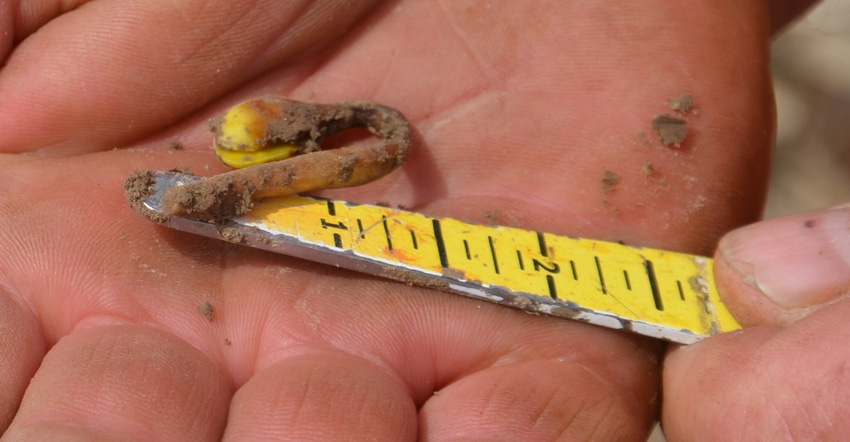
Four years ago, slugs caused a sizable amount of replanting in southeast Indiana and impacted soybean stands in central Indiana as well. Slugs can’t be ruled out during any year, and they were back again in some fields in southeast Indiana this year, causing significant feeding damage and preventing successful germination and emergence in some fields.
One grower reported significant slug feeding in soybeans no-till into cornstalks. The field was planted in early May. Evaluating the field about two and a half weeks later, the grower found areas with virtually no plants visible. When he looked closer, he found soybean stems trying to emerge were cut off. He said it looked like slugs went right down the row, from one seed or seedling to the next, in parts of the field.
Where soybeans did emerge, some had incurred feeding damage. Leaves showed evidence of feeding activity, the farmer reported. He explained that he has experienced some problems with slugs in the past, but only in certain years, like four years ago.
Troublesome pest
Steve Gauck, a regional agronomy manager for Beck’s, also farms with his family in southeast Indiana near Greensburg. He remembers the slug problems from four years ago and notes that they show up in various numbers in other years.
“Weather conditions make a big difference with slugs,” he says. “Cool, wet weather in the spring seems to favor them. However, when there was an outbreak four years ago, we found live slugs still feeding in the Soybean Watch field in central Indiana in late June.”
Normally, soil temperatures warm up by the end of May or early June and slugs seem to disappear as a threat to soybeans, he says. However, in 2017, the Soybean Watch field wasn’t planted until the first week of June, and slugs still thinned stands. That field was no-tilled into cornstalks.
“They damaged some conventionally tilled fields that year as well,” he says. “When conditions are right and an outbreak is extensive, they’re not limited to reduced-tillage fields.”
In the Soybean Watch field four years ago, slugs contributed to stands as low as 80,000 plants per acre in 15-inch rows in parts of the field. “We were still comfortable with those stands, and those beans still made 50 bushels per acre,” Gauck says. “They also contended with a 6-inch rain in one day in early July, which led to some drown-out spots in the field.”
The problem with slugs is several-fold, Gauck says. You don’t know when they’re going to show up, and while there is a chemical treatment approved for them as a preventive, it’s expensive. Once slugs show up, the best remedy is warmer weather.
“Yet in years like 2017, some people replanted and still had issues,” Gauck recalls. If you’re willing to do some tillage if you must replant, it may help but with slugs, there are no guarantees, he says.
“This is a tough pest that is a big deal in those years and fields where it does show up,” he concludes.
About the Author(s)
You May Also Like




